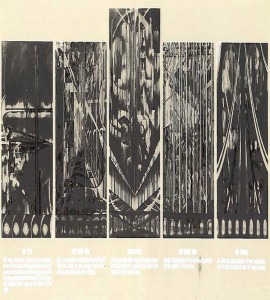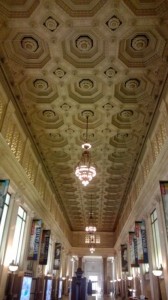
Why limit our appreciation for our volunteers to just one month? Here are a few more of our stellar volunteers that help keep the Smithsonian Libraries running!

Why limit our appreciation for our volunteers to just one month? Here are a few more of our stellar volunteers that help keep the Smithsonian Libraries running!
This post was written by Vanessa Haight Smith, head of Preservation Services.
When repairing older books, the Smithsonian Libraries conservators occasionally uncover evidence of recycling by the original bookbinders. Paper from damaged and discarded volumes was frequently used when binding new books. Why use a new, clean sheet of paper when a leftover scrap would work just as well?
Not to brag, but we’ve got a pretty cool new research tool to show off: OneSearch.
-This post was written by American Art/Portrait Gallery Library (AAPG) Spring 2014 intern Sara Cecilia Johnson.

Joseph Stella’s paintings sit quietly, unnoticed on the second floor of the Smithsonian American Art Museum. People often pass them by, maybe one or two stopping to admire the vibrant color or dynamic movement, but otherwise Stella remains an obscure, unfamiliar name to the average American. What they don’t know about is his striking spectrum of work that evolved during the inter-war period in the 1920s and ‘30s or about his friendships with leading art figures of him time, such as Alfred Stieglitz, Walter Arensberg, Katherine Dreier, and Marcel Duchamp.
It’s springtime in DC. That means squirrels are everywhere on the National Mall. Take a walk around the Mall and you are bound to see a squirrel or two run across your path. Sit on a bench for a few minutes and you might hear a rummaging sound and then see a squirrel pop up out of a trash can. And you are sure to see a squirrel or two getting their picture taken, sometimes looking as if they are posing for the camera!

This post was contributed by Michael O’Connor, contract cataloger.
Directly across the street from DC’s Union Station is the spectacular 1914 neoclassical structure that houses the Smithsonian’s National Postal Museum (NPM). Since July of 2013 I have worked as a project cataloger on NPM Library’s Small Journals Project, an effort to catalog thousands of rare periodicals from the 1800s to the present.
Elements of the philosophy of plants by Augustin-Pyramus de Candolle and Kurt Sprengel is the first edition in English of a composite work by two of the most eminent botanists of the early 19th century. The first three parts on nomenclature, theory of classification, and descriptive botany are from a work by de Candolle, while the final part on the structure and nature of plants is by Sprengel. This book was recently adopted through our Adopt-a-Book program by George Gwynn Hill.